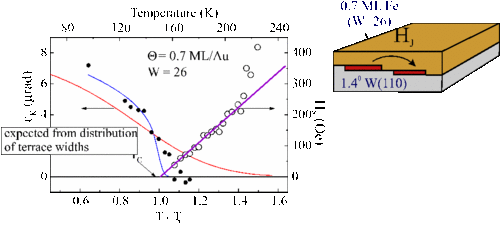Magnetic Nanostructures on Vicinal Single Crystal Surfaces
If the lateral dimensions of a ferromagnet are limited on a nanoscale, surprising new phenomena will show up. There are only a few preparation techniques and analytical tools available for these lengthscales. Self-organized growth mechanisms provide a promising preparation technique for nanostructures resulting in large areas of regular nanostructure arrays. This means a mass production of ferromagnetic structures with nanoscale dimensions that all have the same magnetic properties. For the characterization one can use analytical tools that integrate over a certain area like Kerr magnetometry. However, the interaction of neighboring structures has to be considered, too.
We focus on Fe-nanostructures grown on a vicinal W(110) single crystal surface. A small miscut angle results in parallel monoatomic steps with a regular spacing of the order of 20 nm. At elevated substrate temperatures during the growth, Fe atoms grow in continuous stripes of one or two atomic layers parallel to the W substrate steps. The distance and the width of the stripes can be controlled by the miscut angle and by the total coverage. The reduced dimension of these structures allows an easier approach as well to the properties of isolated stripes as to the interpretation of the interaction of neighboring stripes. In the case of submonolayer coverage separated stripes of monoatomic height are formed which show a new type of magnetic phase transition. Despite the prediction from the one-dimensional Ising-model, they exhibit a sharp phase transition to ferromagnetic order, free from relaxation. The magnetic easy axis is in the plane, but across the stripes. This cross-magnetization induces ferromagnetic dipolar coupling between the spin-blocks in adjacent stripes, which are performed by exchange interactions. The resulting superferromagnetic phase transition is therefore driven by dipolar interactions.
In addition to a dipolar coupling one might suspect that there exists an indirect exchange interaction, similar to the indirect exchange interaction observed for ultrathin magnetic films separated by a nonmagnetic interlayer. In our case the dimension is reduced by one, i.e. we have narrow stripes separated by the nonmagnetic substrate. We find an experimental hint for this effect in the observation that the external field Hs necessary to saturate the magnetization above Tc deviates from the expected behavior Hs = Hdip (T-Tc)/Tc, where Hdip is the dipolar coupling field given by the geometry of the sample.

The Figure shows remanent (dots) order and saturation field (open circles) as a function of temperature. From the increase of the saturation field vs temperature we derive a coupling field of 113mT, considerably larger than the dipolar coupling field of 24 mT.